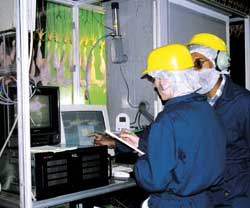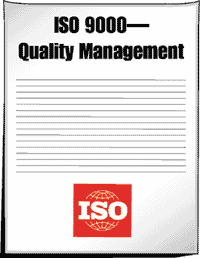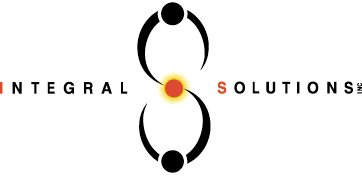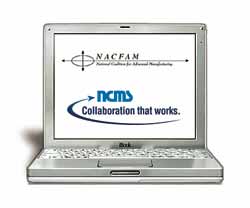Concerns Raised Over Lack of
Winners at Europe's Quality Awards The European
Quality Awards 2001 produced shocking results, as finalists in both the Large Business and Business Unit and Operational Unit categories did not achieve scores high enough to merit top prizes. This is the first time in its 10-year history that the European Foundation for Quality Management's annual program yielded no winners in these categories. "Perhaps this result
underlines the difficulties of European industry in these turbulent times," says Award Jury Chairman John Condron, CEO of Yell. "Many of the finalists came from the semiconductor and enterprise
software sectors, which are in a grip of cyclical downturn. Others are operating in economies where the business climate has most definitely turned hostile." Although there
were no overall winners, the EFQM issued prize-winning status to two companies in the Large Business and Business Unit category--DHL Portugal, a country unit of the global express parcels
carrier, and Westel Mobile Telecommunications Co. Ltd., a Hungarian mobile telecom provider. Condron emphasizes that this year's lack of top prize recipients doesn't mean that
quality in Europe is decreasing. "Unquestionably, the average scores of the finalists--as a group--would be higher than the average of five years ago." Condron further notes
that these results are partly due to the stringent requirements EFQM enforces in order to become a winner. Jury members who rate organizations on a point scale of 1 to 1,000 determine EQA
winners. The scores are based on the organization's ability to follow the EFQM's European Excellence Model, a list of nine criteria for achieving excellence in quality, including leadership,
policy and strategy, partnerships and resources, processes, people results, customer results, society results, and key performance results. When organizations implement the
European Excellence Model, they are required to sharply focus on improvement activities, foster teamwork within the organization, heighten awareness of quality management and create succinct
descriptions of the organization in terms of its activities, ways of working and results. Alain de Dommartin, EFQM's chief executive, says the EQA results only underline the
validity of the EFQM European Excellence Model. "This is not an award with an automatic first prize, and a lot of previous winners appeared as finalists and/or prize winners before they achieved
award-winning status," he explains. "This year's finalists should be justifiably proud of their achievements, and we are confident that we will see a winner next year." Changes
that will affect next year's award results have recently been made to the EQA process. In the past, the EFQM has recognized applicants in each category on three levels--award winner, prize
winners and finalists. Now, prize winners in each category will no longer exist. Additionally, organizations that are not finalists may still be recognized for achievement in excellence after
assessors personally visit their site. The structure of EFQM's feedback to applicants will be enhanced as well, providing each applicant more in-depth feedback on its key
strengths and areas for improvement, comments on the use of EFQM's Excellence Model and a summary score. To learn more about the European Quality Awards, visit www.efgm.org.  ISO Considers Social Responsibility Standard ISO Considers Social Responsibility Standard
An increasing number of consumers are expressing concern regarding the social integrity of corporations and their operations in the global marketplace," says Nils Ringstedt,
chairman of ISO's Committee on Consumer Policy. This concern is further stressed by an Environics International survey of 25,000 people
in 23 countries. Seventy-nine percent of those polled said they believe large companies should be held "completely responsible" for protecting the health and
safety of workers, 73 percent for protecting the environment and 72 percent for avoiding child labor.
Because of this sentiment, the ISO committee is conducting a feasibility study on the creation of an ISO standard for corporate social responsibility. The forum
operates as a list-serve; e-mail postings are sent to every member of the forum. To join the forum, contact Kernaghan Webb, senior legal policy advisor and chief of
research at the Canadian Office of Consumer Affairs, at webb.kernaghan@ic.gc.ca . There is no cost to participate.
One existing standard for social responsibility is SA8000, developed by Social Accountability International, which was formed in 1997. This standard is modeled
after ISO 9000 and deals with nine core areas of social accountability: child labor, forced labor, health and safety, compensation, working hours, discrimination,
discipline, free association and collective bargaining and management systems. The chief problem with SA8000 might be its less-than-overwhelming popularity.
There are currently 75 SA8000-certified facilities in China, Italy, Spain, Thailand and other European and Asian countries. There is one SA8000-registered facility in
the United States--L.E. Jones Co., a Michigan-based automotive components manufacturer. For more information about SA8000 or SAI, visit www.cepaa.org .
 Let Vision Technology Count Your Chickens Let Vision Technology Count Your Chickens
Most people don't take the adage "Don't count your chickens…" as
seriously as do researchers at the Georgia Tech Research Institute. GTRI recently announced that it's begun field-testing machine vision technology that could lead to
computerized screeners taking over the business of inspecting food at processing plants. The technology, called a systemic screener, has been installed near the front end of
the chicken processing line at Gold Kist's poultry processing plant in Carrollton, Georgia, where cameras scan for defects, such as diseased and improperly bled
birds. The visual data is then translated into the appropriate mechanical commands for proper dispensation of each chicken: The defective chickens are automatically
taken off the production line, and those that pass the test proceed to the next stage of processing.
Although poultry processing is already highly automated, there is still a dependence on manual visual-based product screening. "From beginning to end, live bird to the
shrink-wrapped package, there are places where visual input is required to properly process the product. We're looking at where we can apply machine vision
technology, what would be required and how we can modify our system to run tests and see how it functions," says Wayne Daley, senior research engineer at
GTRI. The ideal end result would be a fully automated food processing system. The screening system is configured to work with USB cameras, similar to home
computer models, which makes commercialization of the technology feasible given its affordability. Daley says that field testing will continue for another few months to
check for accuracy, reliability and usability. GTRI is working on other potential applications of machine vision in poultry
processing (such as determining the orientation of live products and identification of cosmetic defects, including tears, bruises and missing limbs).
GTRI is also developing more intelligent screening machinery that could adapt to product variability. Most current assembly line applications of machine vision
involve single objects of consistent size and shape, but chicken parts vary considerably in those characteristics. Additionally, researchers are working on ways
to incorporate X-ray imaging into machine vision technology to improve accuracy of screening processes after deboning.
Representatives from the citrus and bakery industries have expressed an interest in GTRI's research and are working with the institute on vision techniques for
high-speed imaging of their products for quality evaluation and control processes. To learn more about this and other GTRI projects, visit gresearchnews.gatech.edu .
New Edition of ISO 9000 Compendium Includes ISO 9000:2000 Series The International Organization for Standardization has made available a newly
published edition of its ISO 9000 compendium, which includes the revised ISO 9000:2000 quality management system standards series.
The 424-page abstract, called ISO 9000--Quality Management, is available in English only for about $170. Visit the ISO Web site at www.iso.org or e-mail the
ISO Central Secretariat at sales@iso.ch.  "It is useful for managers implementing ISO
9000 programs, for top management who want to gain an ISO overview, for trainers, consultants, registrars, accreditors and business management academics students,"
says Roger Frost, ISO's press and communication manager. "It is useful for managers implementing ISO
9000 programs, for top management who want to gain an ISO overview, for trainers, consultants, registrars, accreditors and business management academics students,"
says Roger Frost, ISO's press and communication manager.
The compendium is a companion book for the "ISO 9000 Selection and Use" and "Quality Management Principles" brochures,
as well as ISO's other publications, which include the newly launched ISO magazine, ISO Management Systems and the ISO 14000 Compendium. The book also contains
information about a forthcoming edition of ISO 9000 for Small Businesses, which is slated for publication at the end of the first quarter of 2002.
This is the ninth published ISO 9000 compendium since 1991. It gathers in one volume the 14 standards and technical reports currently making up the ISO 9000
family. This includes ISO 9000, ISO 9001 and ISO 9004, revised versions of which were published in December 2000 to focus on helping organizations achieve
customer satisfaction and continual improvement. "Until now, too much of the ISO 9000 emphasis has been on certification
standards," adds Frost. "Gradually, because of ISO publications such as the 'ISO 9000 Selection and Use' brochure and the formidable communication effort
accompanying the launch of the ISO 9000:2000 series, the realization that optimal benefits can be obtained by the integrated use of the standards and other documents
in the ISO 9000 family is taking hold. The compendium gathers the whole family in one handy volume."
The compendium also includes drafts of three additions to the ISO 9000 family: ISO 19011 on joint ISO 9000 quality and ISO 14000 environmental management
system audits, ISO 10012 on measurement control systems and ISO 10013 on quality management system documentation. For more information, visit the ISO Web site at www.iso.org. ASQ Looks to Expand Globally With WorldPartners
The American Society for Quality recently approved the applications of six organizations to join its budding WorldPartner program, which was created to build
a global information network for quality organizations. New members are the Union of Japanese Scientists and Engineers, Excellence Ireland, Center for Excellence
Finland, the Hong Kong Society for Quality, PGQP Brazil and the Israel Society for Quality. These join IPACE of Argentina, bringing the total to seven.  ASQ's WorldPartner program was developed in May of 1998, when the
organization chartered an international task force with the goal of studying trends in globalization and developing a comprehensive strategy for incorporating itself globally. "Prior
to this, ASQ assumed a passive response to international relations and opportunities," says Michael O'Donoghue, global development
manager at ASQ. His job was created after reports from the task force indicated a need for a full-time position specifically dedicated to working with international
relations and business development. ASQ's WorldPartner program was developed in May of 1998, when the
organization chartered an international task force with the goal of studying trends in globalization and developing a comprehensive strategy for incorporating itself globally. "Prior
to this, ASQ assumed a passive response to international relations and opportunities," says Michael O'Donoghue, global development
manager at ASQ. His job was created after reports from the task force indicated a need for a full-time position specifically dedicated to working with international
relations and business development. "Before 2000, ASQ had loosely formed affiliates--relationships that didn't fully
serve either party and implied a relationship of ASQ dominance," adds O'Donoghue. "These affiliate relations will be phased out in June. The WorldPartner program replaces it."
Inclusion into the WorldPartner program entails conforming to a set of guidelines developed by ASQ. Not-for-profit quality associations are first required to complete
a profile (ASQ shows its own profile to organizations as an example and a gesture of goodwill). The organization then submits its profile to the ASQ's International
Cooperation Committee, which determines whether it will receive a site visit. From there, discussions begin between the ASQ and potential partners and a "Strategic
Plan of Cooperation" is developed, which outlines a business and activity plan during a two-year period.
"The WorldPartners enjoy a ready exchange of articles from each other's publications, preferential consideration in business relations, public relations sharing,
and recognition, conference promotions and potential for research collaboration activity," O'Donoghue explains.
The WorldPartner program does face a few obstacles. "Challenges include communication across geography, time zones, culture and languages," says
O'Donoghue. ASQ hasn't set a target number of WorldPartner participants. "We want quality in our relations before any quantity measure, so the program will
continue to grow as the number of interested organizations grows," O'Donoghue continues. To learn more about ASQ's WorldPartner program, visit www.asq.org/global/worldpartners .
CEJohansson Metrology Gets ISO/IEC 17025-1999 Accreditation Officials at CEJohansson Metrology Services Laboratory have announced that the
company has received ISO/IEC 17025-1999 accreditation for calibration and mechanical testing fields, as well as an ANSI/NCSL Z540-1-1994 compliance. The
accreditation comes from the American Association for Laboratory Accreditation. CEJohansson Metrology Services, the first public laboratory to perform
dimensional measurement accredited by the A2LA, performs calibration for  dimensional measurement instruments and
provides dimensional inspection services, reverse engineering, CAD services and consulting on dimensional measurement problems. It has been accredited by A2LA
in mechanical testing for more than 10 years. The company adheres to the requirements of ISO/IEC 17025--General
requirements for the competence of calibration and testing laboratories, which is in compliance with the ISO 9000 standards series. dimensional measurement instruments and
provides dimensional inspection services, reverse engineering, CAD services and consulting on dimensional measurement problems. It has been accredited by A2LA
in mechanical testing for more than 10 years. The company adheres to the requirements of ISO/IEC 17025--General
requirements for the competence of calibration and testing laboratories, which is in compliance with the ISO 9000 standards series.
"The certification expands our training offerings and lends additional confidence to customers who rely on us for measurement consulting capabilities, such as analysis
of geometry or determining how specific parts must be manufactured to fit together precisely," says Sam Lindhorst, principal metrologist at CEJohansson.
CEJohansson is a division of Newport Corp., a designer, manufacturer and marketer of high-precision components, instruments and integrated systems to
fiberoptic communications, semiconductor equipment, aerospace, and research and industrial metrology markets. For more information, visit www.cejmetrology.com/lab .  National Quality Measures National Quality Measures
Clearinghouse Proposed
Doctors, nurses and other medical technicians usually have no problem finding documented resources for proper health care
procedure; even the World Wide Web houses databases of detailed guidelines for appropriate treatment of a patient. But what about health care administrators and
researchers? What rules should they follow for distributing a quality health care system? The Agency for Healthcare Research and Quality has plans to provide a Web-based
National Quality Measures Clearinghouse, which it hopes will help answer these questions. "We expect that the NQMC will be useful for people and organizations
that develop and use quality measures. This includes not only researchers but also people and organizations on the front line of delivery of quality health care," says
NQMC Project Manager Jean Slutsky. The project will provide a database that houses the NQMC and the agency's
current National Guideline Clearinghouse, which was developed in partnership with the American Medical Association and the American Association of Health Plans.
The difference between the two systems is that the NGC contains details on clinical practice guidelines, but the NQMC will house information on quality measures in the health care industry. Once the project is complete, NQMC and NGC will be accessible through individual URLs as well as an umbrella site. Although each site will possess a unique
Web address, both will share a common information system infrastructure and backbone database system. "Many users will be interested in the content of both the
NGC and the NQMC," Slutsky says. "There will also be users who will be mostly interested in only one of the other of the Web sites. The two projects are
complementary and we hope that the NQMC will be as well received as the NGC." The contract for the $8.4 million project was awarded to Emergency Care
Research Institute, a Pennsylvania-based, nonprofit health services organization. Under the direction of ARHQ, ECRI will perform all technical duties for the clearinghouse.
AHRQ expects the clearinghouse to be operational on the Web in about 15 months. Slutsky says that development of the clearinghouse is the first step in a plan to
create a series of Internet-based tools for those in the health care industry. Learn more by visiting www.ahrq.gov. Industry News  JetBlue Switches to Pilgrim Software JetBlue Switches to Pilgrim Software
Auditors at JetBlue Airways will now enter their surveillance findings using Pilgrim Software's Audit/Survey software. JetBlue, which offers flights from New York
City to 17 cities in the United States, will use the software for surveillance of both internal and external processes. "The ability of Pilgrim's Audit/Survey module to perform
remote surveillance was a critical deciding factor for JetBlue," says Director of Sales Phil Keeling. Pilgrim's
Audit/Survey module gives auditors the capability to check audits into and out of the main database with laptop computers. They can then carry an electronic record to
the site, perform surveillance and send the data back through the main server. For more information on Pilgrim Software, visit www.pilgrimsoftware.com .
 Alamo Helps High-Tech Group With ISO Registration
Alamo Helps High-Tech Group With ISO Registration
AeA, the nation's largest high-tech trade association, has
announced a partnership with Alamo Learning Systems. Alamo will help AeA's member companies prepare, operate and maintain ISO registration. "Alamo has a
proven track record of helping high-tech companies save time and money during the ISO registration process," says AeA's Angela Pellegrino. Alamo Learning Systems
specializes in high-tech ISO 9000 consulting and training. The partnership will provide AeA's more than 3,500 member companies discounted use of Alamo's ISO
9000 services. For more information, visit www.aeanet.org .  ISI Partners With Tennessee Distributor ISI Partners With Tennessee Distributor
Nashville-based SON Systems and Services is now the Tennessee distributor of Integral Solutions Inc.'s products and software, training services, quality methodology training and
internal quality auditing. SON Systems is also a distributor of CimWorks GageTalker (a division of GE Fanuc) products. "A major factor in our decision to
partner with ISI is the ability of ISI's DPACT and MPACT software to export to CimWorks GageTalker SPC software," says Robert Boyd, president of SON Systems. Learn more by visiting www.integralsolutions.com .  Manufacturing Groups Combine Web Resources Manufacturing Groups Combine Web Resources
The National Center for Manufacturing
Sciences and the National Coalition For Advanced Manufacturing recently entered into a partnership in which their Web sites will feature links to each other's member sections. This will give
members of either organization instant access to both the NCMS's and NACFAM's research and development reports, publications and journals, discounted products and services,
legislative news and cross-industry networking opportunities. For more information, visit www.ncms.org and www.nacfam.org. |